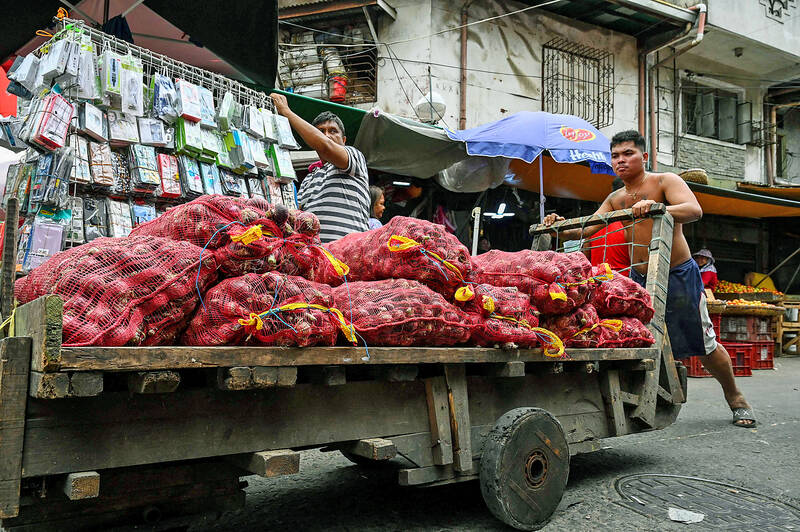Even before his onions are fully grown, Philippine farmer Luis Angeles races to harvest the crop and cash in on eye-watering prices for a vegetable that has become a luxury item in the country.
Onion prices have soared in the past few months, reaching as high as 800 pesos (US$14.67) per kilogram in Manila supermarkets, making them more expensive than chicken or pork.
Some restaurants have stripped the staple ingredient from dishes, while many families already grappling with the highest inflation in 14 years have stopped eating them.

Photo: AFP
To meet demand and push retail prices back below 200 pesos, the government has approved the importation of 21,000 tonnes of onions and faces calls to crack down on traders suspected of hoarding.
However, prices remain stubbornly high and onion farmers like Angeles have been harvesting earlier than usual to reap the windfall.
“What is happening is historic,” Angeles, 37, said, as his workers pulled undersized red and white bulbs out of the soil near the northern town of Bongabon, the country’s self-proclaimed “onion capital.”

Photo: AFP / Handout / RR Productions
“This is the first time that prices have reached this level,” he said.
When he began harvesting last month, Angeles received as much as 250 pesos per kilogram for his crop.
By the time his onions reached Manila supermarket shelves, the price had more than doubled, exceeding the daily minimum wage.
“I told my family: ‘Let’s just smell the onion instead of eating it,’” Candy Roasa, 56, said as she walked through a market in the capital where she has seen vendors selling bulbs the size of a small child’s fist for as much as 80 pesos each.
As onion memes spread on social media, the humble vegetable has become a symbol of wealth in the poverty-afflicted country.
At least one bride used pricey bulbs instead of flowers for her wedding bouquet.
Philippine Airlines crew members on a recent flight from the Middle East were busted trying to smuggle a few bags of the pungent commodity through Manila’s Ninoy Aquino International Airport.
It is not the first time the Philippines has experienced a shortage of a basic food staple that caused prices to spike — sugar, salt and rice have all been hit in the past.
Poor yields, high costs, insufficient investment in irrigation and machinery, lack of access to cold storage facilities and farm-to-market roads, and crop-destroying typhoons have long affected the sector.
Pest outbreaks as well as soaring oil and fertilizer prices since Russia invaded Ukraine last year have only added to farmers’ woes.
Despite government pledges to boost domestic food production, the country relies heavily on imports to feed its growing population — but tariffs fuel inflation.
Philippine President Ferdinand Marcos Jr appointed himself agriculture secretary to overhaul the near-moribund industry, which accounts for about one-quarter of the country’s employment, but only makes up 10 percent of GDP.
“Our agriculture sector is significantly challenged,” said Geny Lapina, an agricultural economics and management professor at the University of the Philippines.
Every Filipino eats an average of 2.34kg of onions per year and theoretically the country produces enough to meet the demand, official data showed.
Since the tropical climate only allows one planting per year of the rain-averse crop, stocks are consumed or spoil well before the next harvest.
The recent lifting of COVID-19 restrictions, which allowed the resumption of food-focused festivals and family gatherings for Christmas, triggered soaring demand for onions.
Former secretary of agriculture William Dar said the shortage could have been avoided if the current government had allowed imports in August last year.
“This is the net result of the poor planning,” Dar told local broadcaster ABS-CBN.
There are growing concerns about future food security in the Philippines, which is ranked among the most vulnerable nations to the effects of climate change and is plagued by poor nutrition.
The median age of farmers is 57 and the average farm plot has shrunk to about 1.3 hectares from nearly 3 hectares in the 1960s.

‘CHILD PORNOGRAPHY’: The doll on Shein’s Web site measure about 80cm in height, and it was holding a teddy bear in a photo published by a daily newspaper France’s anti-fraud unit on Saturday said it had reported Asian e-commerce giant Shein (希音) for selling what it described as “sex dolls with a childlike appearance.” The French Directorate General for Competition, Consumer Affairs and Fraud Control (DGCCRF) said in a statement that the “description and categorization” of the items on Shein’s Web site “make it difficult to doubt the child pornography nature of the content.” Shortly after the statement, Shein announced that the dolls in question had been withdrawn from its platform and that it had launched an internal inquiry. On its Web site, Le Parisien daily published a

China’s Shenzhou-20 crewed spacecraft has delayed its return mission to Earth after the vessel was possibly hit by tiny bits of space debris, the country’s human spaceflight agency said yesterday, an unusual situation that could disrupt the operation of the country’s space station Tiangong. An impact analysis and risk assessment are underway, the China Manned Space Agency (CMSA) said in a statement, without providing a new schedule for the return mission, which was originally set to land in northern China yesterday. The delay highlights the danger to space travel posed by increasing amounts of debris, such as discarded launch vehicles or vessel

RUBBER STAMP? The latest legislative session was the most productive in the number of bills passed, but critics attributed it to a lack of dissenting voices On their last day at work, Hong Kong’s lawmakers — the first batch chosen under Beijing’s mantra of “patriots administering Hong Kong” — posed for group pictures, celebrating a job well done after four years of opposition-free politics. However, despite their smiles, about one-third of the Legislative Council will not seek another term in next month’s election, with the self-described non-establishment figure Tik Chi-yuen (狄志遠) being among those bowing out. “It used to be that [the legislature] had the benefit of free expression... Now it is more uniform. There are multiple voices, but they are not diverse enough,” Tik said, comparing it

RELATIONS: Cultural spats, such as China’s claims over the origins of kimchi, have soured public opinion in South Korea against Beijing over the past few years Chinese President Xi Jinping (習近平) yesterday met South Korean counterpart Lee Jae-myung, after taking center stage at an Asian summit in the wake of US President Donald Trump’s departure. The talks on the sidelines of the APEC gathering came the final day of Xi’s first trip to South Korea in more than a decade, and a day after his meeting with the Canadian prime minister that was a reset of the nations’ damaged ties. Trump had flown to South Korea for the summit, but promptly jetted home on Thursday after sealing a trade war pause with Xi, with the two